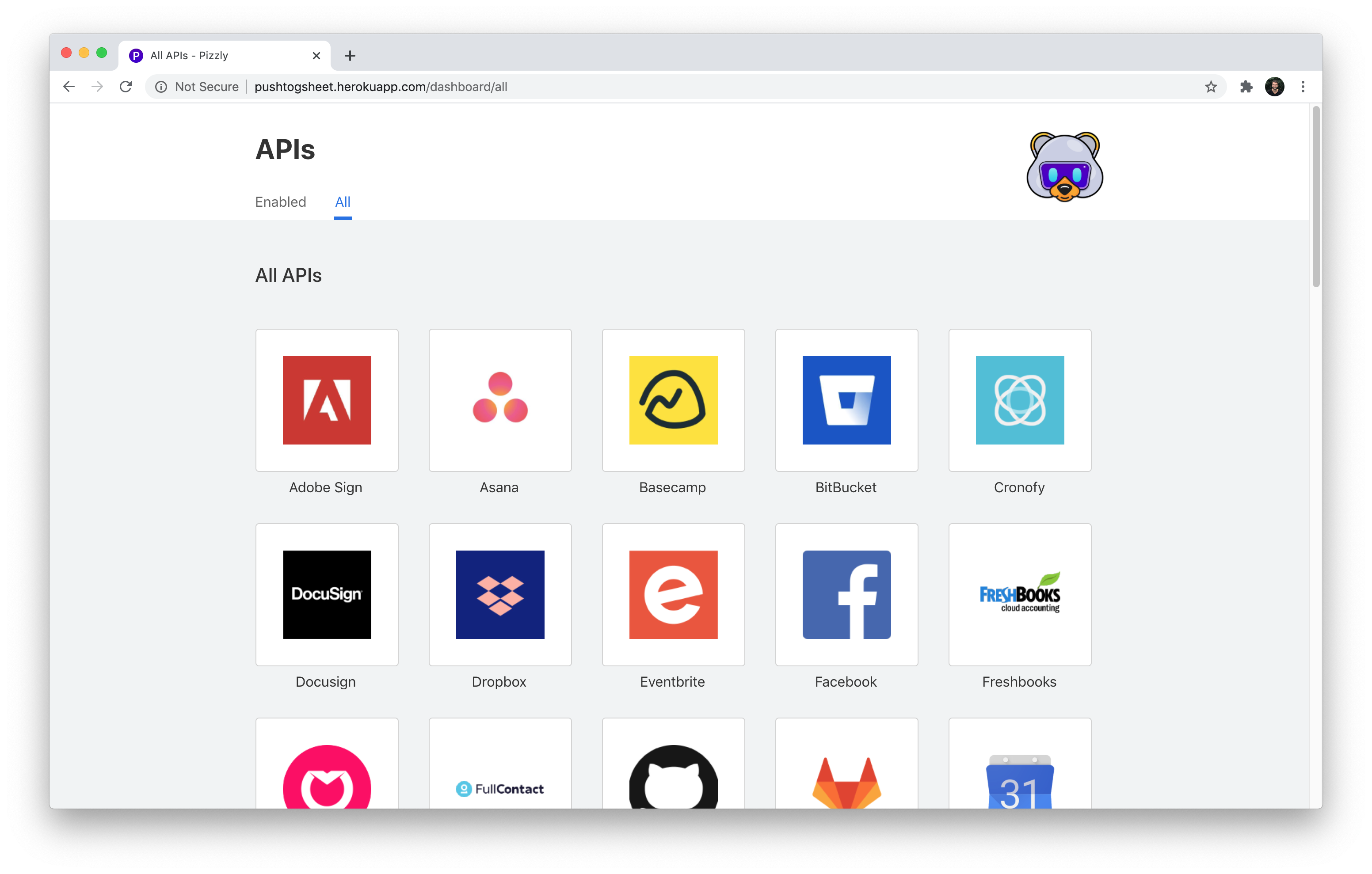⭐ Pizzly is looking for new maintainers! If you're interested, check out the discussion post. ⭐
Pizzly makes it fast and reliable to build API integrations. It handles dozens of pre-configured APIs (including Salesforce, Slack, Google Sheets and many more) and lets you quickly add more APIs with a generic JSON configuration schema.
Using Pizzly your engineering team can focus on consuming APIs, in a standardized way that will grow as you grow.
At the heart of Pizzly is a Node.js application that uses PostgreSQL as a database. Once deployed on your servers, each instance of Pizzly provides multiple tools to help developers with their API integrations, including:
- a dashboard - to enable and configure APIs;
- an auth service - to handle the OAuth-dance;
- a proxy - to perform authenticated requests to an API;
- a JS library - to connect a user and perform requests from your frontend;
- and its own API - to programmatically do what you can do with the dashboard.
Pizzly can be installed anywhere (AWS, Heroku, Platform.sh, etc.). Here's a quick guide:
-
First, deploy your own instance of Pizzly by clicking a deploy button below:
Heroku Platform.sh -
Once deployed, open your app. You will land on Pizzly's dashboard.
-
Click on "Open Dashboard" and select the API you want to integrate with.
-
Now, configure the API by entering your credentials and scopes. That's all it takes to configure a new API.
-
To connect a user to this API, in your frontend, install
pizzly-js:npm install pizzly-js
-
Then open your frontend app and copy-paste the following code:
import Pizzly from 'pizzly-js' const pizzly = new Pizzly({ host: 'pizzly.example.org' }) // Initialize Pizzly const myAPI = pizzly.integration('xxx-api-name') // Replace with the API slugname myAPI .connect() .then(({ authId }) => console.log('Sucessfully connected!', authId)) .catch(console.error)
This snippet code will open a popup in your browser to start an authorization flow with the provided API. On success you will obtain an
authIdwhich will be be used in the next step. -
In your frontend again, use the previously obtained
authIdto perform a request to the API using the code below:myAPI .auth('xxx-auth-id') // Replace with the authId previously obtained .get('/xxx-endpoint') // Replace with a valid endpoint of the API .then((response) => console.log(response)) .catch(console.error)
This example will perform a GET request to
/endpointof the API and will use the provided authId to authenticate the request.
Guides, tutorials and references are all available on the Docs.
We have several examples in the docs with different APIs. Here is the first one to get you started:
const pizzly = new Pizzly({ host: 'pizzly.example.org' }) // Initialize Pizzly
const github = pizzly.integration('github')
github
.connect() // Connect to GitHub
.then(({ authId }) => console.log('Sucessfully connected! with the authId:', authId))
.catch((error) => console.error('It failed!', error))This example will trigger an OAuth dance to the GitHub API.
💡 You'll notice that when a user is successfully connected, we received an authId; it's a power concept introduced by Pizzly. The authId acts as a reference to the OAuth payload (i.e. the access_token and refresh_token). While the access_token and refresh_token expire and/or change over time, the authId is always the same. Think of it as something like a user identity.
More than 50 APIs are preconfigured to work out-of-the-box. Including:
- Communication: Gmail, Microsoft Teams, Slack, Zoom;
- CRM: Front, Hubspot, Salesforce, etc.
- Developer tools: BitBucket, GitHub, GitLab, etc.
- Finance: Xero, Sellsy, Zoho Books, etc.
- Productivity: Asana, Google Drive, Google Sheets, Jira, Trello, etc.
- Social: Facebook, LinkedIn, Reddit, etc.
- and more...
Each API consists of a JSON configuration file, stored within the /integrations directory. Here's an example with the GitHub configuration file (/integrations/github.json):
{
"name": "GitHub",
"auth": {
"authorizationURL": "https://github.com/login/oauth/authorize",
"tokenURL": "https://github.com/login/oauth/access_token",
"authType": "OAUTH2",
"tokenParams": {},
"authorizationParams": {},
"auth": { "accessType": "offline" }
},
"request": {
"baseURL": "https://api.github.com/",
"headers": {
"Accept": "application/vnd.github.v3+json",
"Authorization": "token ${auth.accessToken}",
"User-Agent": "Pizzly"
}
}
}And adding new APIs is straightforward. Just create a new configuration file within the /integrations folder of your Pizzly's instance. If you feel like sharing, you can even create a PR so that other developers will be able to use it as well!
Pizzly originally started at Bearer as a way to simplify the developer's journey and ease the building of API integrations. OAuth is a great framework, but the difficulty and wide range of implementation makes it painful to use and tends to slow down the ability to integrate with new APIs.
But seriously, why Pizzly? We're fan of bears and fell in love with this sweet hybrid one 🐻
While Pizzly is actively backed by Bearer's engineering team, the main purpose of this repository is to continue to improve Pizzly, making it larger and easier to use. We are grateful to each contributors and encourage you to participate by reporting bugs, ask for improvements and propose changes to the code.
Pizzly has adopted the Contributor Covenant Code of Conduct (version 2.0), available at https://www.contributor-covenant.org/version/2/0/code_of_conduct.html. We expect project participants to adhere to.
All work on Pizzly happens directly on GitHub. Both Bearer.sh team members and external contributors send pull requests which go through the same review process. Submit all changes directly to the master branch. We don’t use separate branches for development or for upcoming releases.
To report a bug or a feedback, use GitHub Issues. We keep a close eye on this and try to label each new request. If you're fixing a bug or working on a new feature, submit a pull request with detail on which changes you've made.
While there are no templates yet when opening a PR or an issue, we still recommend to provide as much detail as possible. Consider that someone external to the project should understand your request at first glance.
Pizzly is MIT licensed. See the LICENSE file for more information.
Pizzly is proudly sponsored by Bearer, a solution to implement data security as code processes in developers' workflows and automate data detection and data flow mapping.


